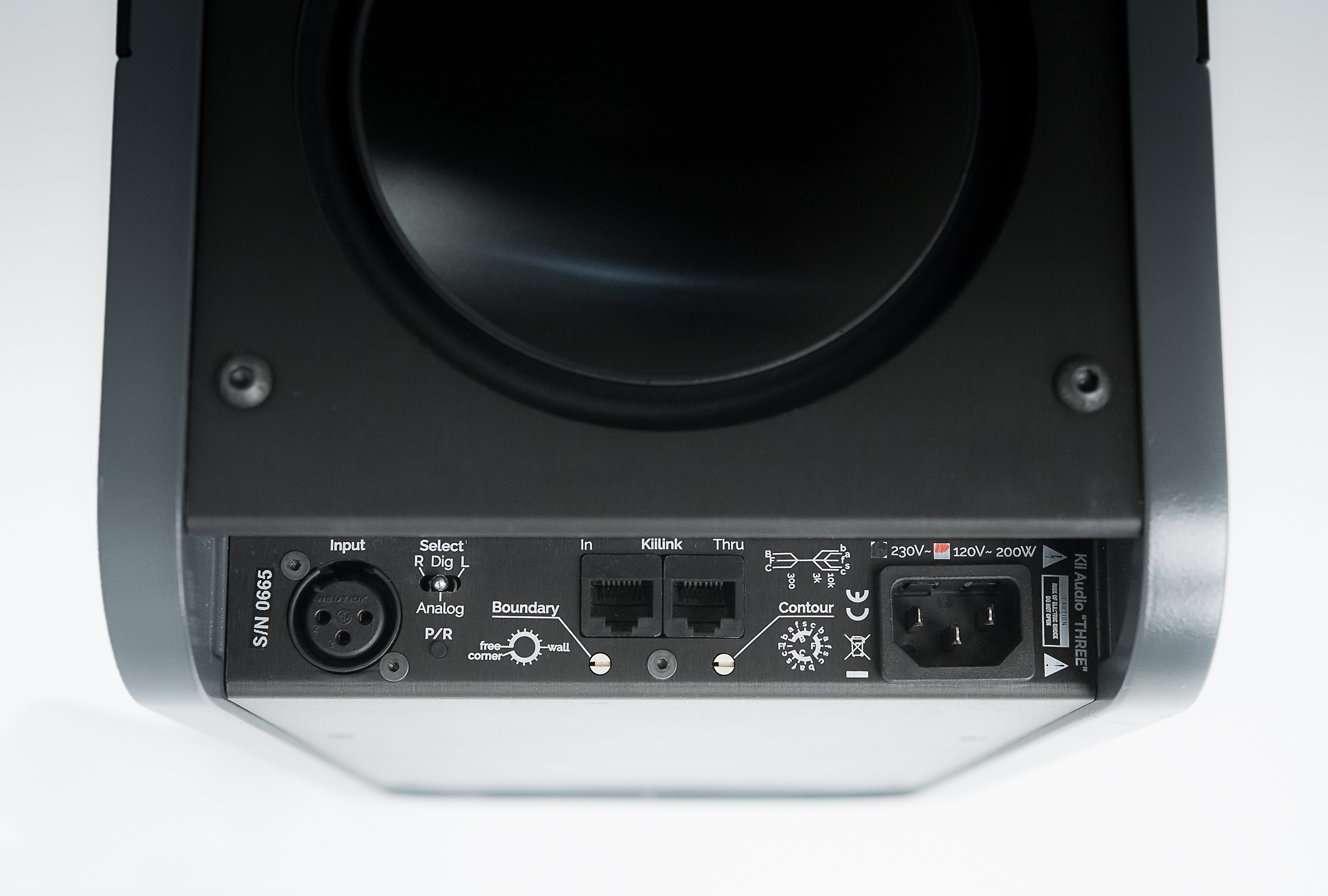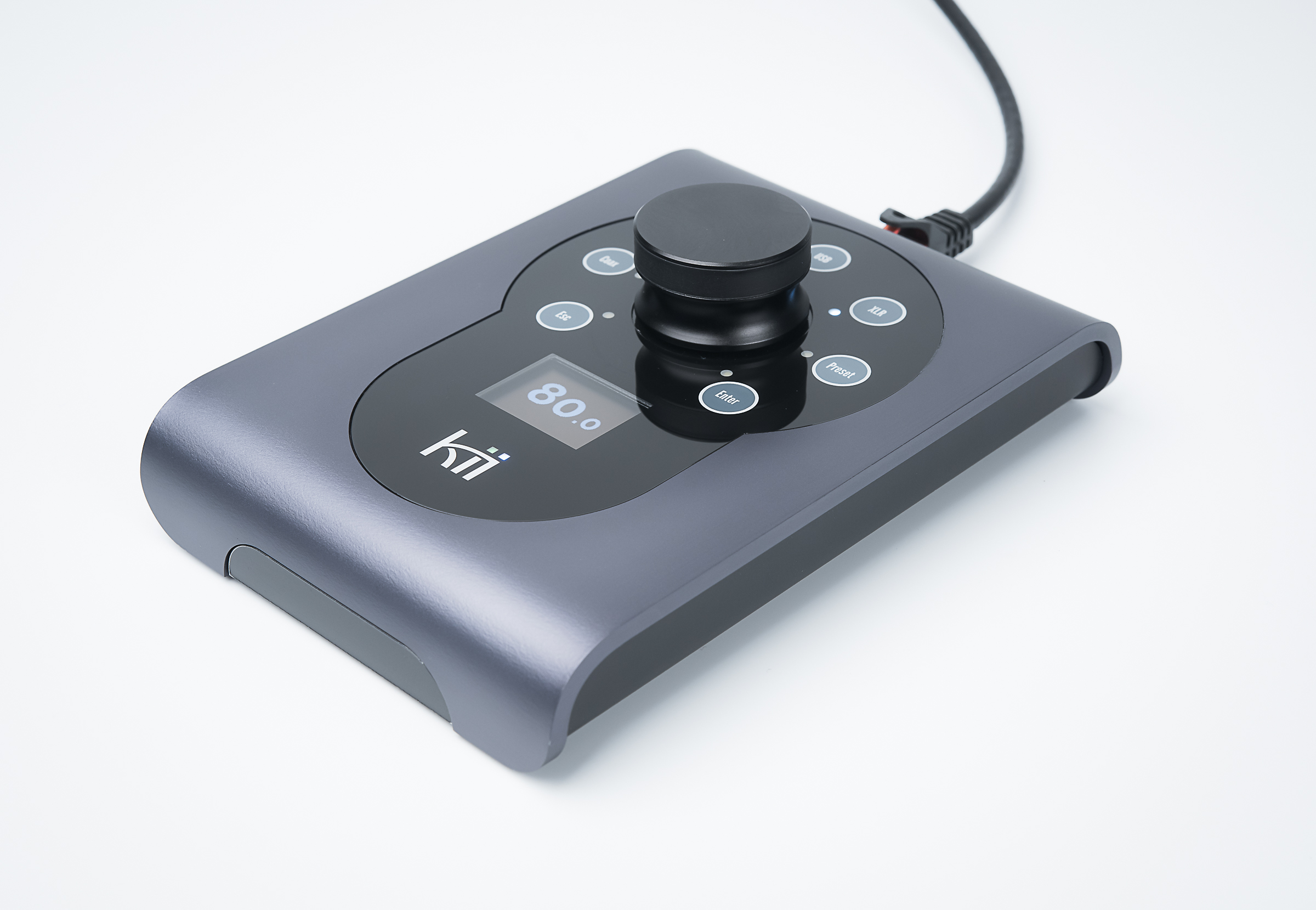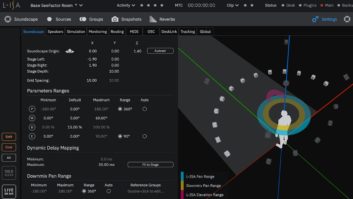Kii Audio was founded in 2014 by a team including Bruno Putzeys, the designer of the Grimm Audio LS1. This compact audiophile speaker received warm reviews due to its ability to deliver a wide frequency response with great accuracy, especially when considering its relatively small size. The Kii Three aims to build on these strengths, delivering an even more compact reference monitor meant to reproduce sound on par with soffit-mounted main monitors or tower speakers found in mastering suites.
Kii Threes use six drivers arrayed across four different surfaces of the cabinet. By using a precise digital crossover, which plays as much a role in timing and phase coherency as it does in frequency division, the Kii Three promises detail and articulation across a wide frequency response. On top of that, the directionality imparted by the many drivers working in concert immunizes the speaker from common room-related artifacts known to damage perceived frequency response.

The Hardware
The monitor is relatively tall and narrow, but keep in mind that the side panels are effectively square-shaped, so the cabinets are just as deep as they are tall. While some monitor manufacturers strongly advise against laying the cabinets on their sides, with the Three, it is a flat-out “no,” as you would be laying the monitor on one of its woofers. Be ready with sturdy stands that can accommodate their 16-inch depth at 33 pounds. If you purchase a pair, you can pick up Kii’s custom steel stands as well.
The front surface features rounded left and right corners but is sculpted to flare out, framing the front-panel midrange driver. A brushed aluminum panel serves as the mounting point for this 5-inch component, which is covered by a cloth grille. A large waveguide is attached to this panel as well, at the center of which sits the 1-inch tweeter, guarded by a fine-mesh metal grille. The left and right side panels each feature identical exposed 6.5-inch woofers. Two more 6.5-inch woofers, matched to the side-mounted pair, run vertically down the back panel.
Each of these components is driven by its own 250-watt Class D amplifier, which is a customized version of the Ncore model that Putzeys developed for Dutch-based Hypex.
My initial perception of the design led me to believe that it aimed to throw smaller amounts of low-frequency energy to different parts of the room to counteract room modes, similar to what others have been doing with multiple subwoofers. That is not the case at all with the Three. Instead, the strategic placement of the drivers in the housing, coupled with the timing and phase relationship imparted by the DSP-based crossover, modify the sound field in a way more akin to the manipulation of polar patterns in a multi-capsule microphone. By harnessing phase-related additions and cancellations, the system can maintain directionality down to a much lower frequency than other compact monitors have been able to do.
Related: The New Wave of Studio Monitors: High-End, Nearfield, Three-Way Systems, by Strother Bullins, Mix, March 22, 2017
On the lower rear of each unit sits a small panel of controls and connections. The design of the cabinet is not specific to a left or right designation. Each Kii Three monitor has a single XLR connector that can be used for analog or AES/EBU input signal, as well as a pair of RJ45 (Ethernet) connectors for linking Kii monitors and controllers. When feeding AES/EBU signals to the monitor pair, for example, the audio data is fed to the XLR on a single unit and passed to the other through the Ethernet connection. In this case, a switch on each monitor designates whether that unit will play the left or right input signal.

An Ethernet port is used to connect the optional Kii Control, a handy desktop remote control with an integrated audio interface. In addition to providing an access point to feed S/PDIF and Toslink signals to the monitors, Control has a USB connection to receive audio directly from a computer, with buttons to toggle between inputs. The primary function of the Kii Control, however, is level control and access to DSP-based equalization functions. While presets for the Baxandall-style EQ and low-frequency correction, dubbed “Boundary Control,” can be accessed using single screw-driven controls per function on the back panel, it is far more practical to make these adjustments using the Control in front of the monitors.
Setup and Playback
For me, the easiest setup was to swap out my usual primary monitors, using the existing power and analog audio cables instead of making an AES/EBU connection. While I was still relying on my monitor controller for level control and mono summing, I did connect the Kii Control as an easy way to access additional DSP functions. The remote also provided easy access to another function that was mirrored on the back panel, and whose importance I didn’t discover until I got to know the monitors.
When I first put up the Threes, I was working on a commercial that was loaded with sound effects. Pops, whooshes and hits all matched with animations. Most of the effects had come over from the picture editor in the AAF file, and, as is often the case, some of them needed nudging. Something seemed strange, though, as Pro Tools sync points weren’t hitting correctly. While I was double-checking the mix on headphones connected directly to the monitor controller, I noticed that the effects were flamming between the headphones and the Threes. Recording the delayed sound between the two, I clocked the delay at 89 ms.
Eben Grace of Grace Design, who is handling the U.S. distribution of the Threes, referred me to the manual, which regards this as a known issue. Basically, to perform their phase-magic cardioid performance, the monitors incur 90 ms of latency. When using the Threes for sound-for-picture applications or control room overdubs, a low-latency mode can be engaged. Eben said that this mode “does a little fancy footwork with the filters and DSP to arrive at 1 ms of latency.” I tried to identify a perceptible difference between the two modes, but aside from the sync being correct, there was nothing I could credibly pin down in a blind test. That said, it is still recommended to use the “latent” mode when possible, and employ low-latency when necessary.
When I first started playing music, I was floored by the overall frequency response. Usually, with 6.5-inch woofers, the lowest lows are coming from the port and have a woody, airy feel. This low end of the Threes extended down below the range usually associated with drivers smaller than the 8 inches and arrived with a clean, defined precision that I’ve never heard in my control room. It was reminiscent of something I’ve only experienced in mastering suites with big tower monitors and amazing acoustics, where the air seems to move with perfectly calculated efficiency.

The center image was interesting. When listening to a variety of modern pop music, I consistently noticed that the lead vocal and other centered mix elements seemed completely isolated from the rest of the mix. If I closed my eyes, it sounded like there was a third speaker, pushed a little further back between the other two. It seemed like this was an aspect of modern mixes that the monitors were exposing more than a sound associated with the monitors themselves, because when listening to jazz or classical music, or even live albums from rock bands, the stereo image was smooth from left, through the center to the right.
In fact, when listening to an older, roomy jazz recording, the monitors painted an exceptional picture of the players’ positions in the room. Overall, the room reflections in the recording had a very nice three-dimensional quality. The double bass delivered a thick low-mid punch that cut through the mix, and the drums sounded like they were right in front of me. Similarly, when listening to acoustic folk music, the guitar was accurate, and the singer sounded like he was in the room. In all cases, there was a clarity and separation of the instruments.
I liked the way the monitors didn’t need to be cranked to wake up the low end or make it possible to analyze detail in the upper midrange. I’ve often heard mastering engineers talk about how they like to monitor at a level where you can still comfortably have a conversation in the room. With many monitors, I’ve found this impossible, as I’ve had to go much louder than that for the low end to excite the cabinet and the room. With the Threes, every detail from the lows up through the highs was punchy and present even at very low levels. I never felt inclined to listen at high volumes; much more pleasant.
Related: Monitors Articles in Mix Magazine
While I walked around the room, the center did a relatively good job of staying put between the speakers. The low end didn’t appear to build up or drop out. When moving back to the sweet spot, however, everything locked in. The bass jumped in perceived level, the center became very grounded, and the stereo image extremely wide. I was using them in a smaller room, with the tweeters only about 3 feet apart, so this sweet spot was relatively narrow. I feel like I was typically running the monitors at a fraction of their available power. Even when I cranked them to uncomfortable levels, hip-hop kicks and low end hits in trailers didn’t seem anywhere close to the point of distortion.
The Threes are a great companion for mixing. The extended low end did a great job of exposing noises and problems in certain tracks that called for filtering. At the same time, the detailed midrange and high end did an incredible job of exposing phase-related byproducts of equalization outside of the targeted frequency. You could also feel the subtlest changes in compression settings across the entire track.
Overall, mixes translated very well to other monitors. Running the monitors flat, in my case, I seemed to be exaggerating top end in my mixes. A subtle boost of 1.5-3 dB, cornered at 3 kHz, seemed to put everything in order and flatten out my mixes.

Here to Stay?
The Kii Threes are something different. If money were no object, I would insist on keeping them, because they make mixing easier and listening to music more fun. But at $12,795 per pair, plus another $1,895 for the Control, they might be out of the price range for many. For studio monitors, that means you’re going up against Barefoot and ATC, which are established household names. But if you’re looking in that range, check out the Kii Threes.
Brandon T. Hickey is a recording engineer and audio post professional based in Arizona.
Product Summary
Company: Kii Audio
Product: Three
Website: www.kiiaudio.com
Price: $12,795 (per pair), Kii Control $1,895
Pros: Full, tight low end from a compact monitor; great detail and image.
Cons: High price tag; tightly focused sweet spot.







